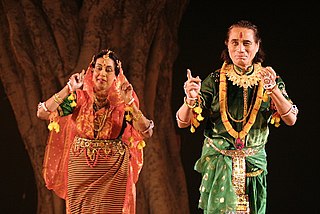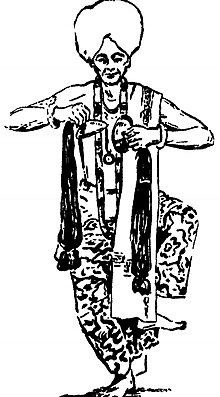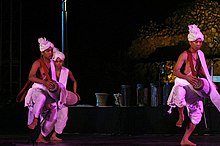Sattriya, or Sattriya Nritya, is a major Indian classical dance. This dance was initially created as part of Bhaona which are performances of Ankiya Nat, one-act plays, originally created by Sankardev, the 15th-16th century polymath from Assam. These dances are part of the living traditions today of Sattras, which are communities of live-in devotees belonging to the Ekasarana dharma, the religion established by Sankardev.

The Manipuri Dance, also referred to as the ManipuriRaas Leela, is a jagoi and is one of the eight major Indian classical dance forms, originating from the state of Manipur. The dance form is imbued with the devotional themes of Madhura Raas of Radha-Krishna and characterised by gentle eyes and soft peaceful body movements. The facial expressions are peaceful mostly expressing Bhakti Rasa or the emotion of devotion, no matter if a dancer is Hindu or not. The dance form is based on Hindu scriptures of Vaishnavism and is exclusively attached to the worship of Radha and Krishna. It is a portrayal of the dance of divine love of Lord Krishna with goddess Radha and the cowherd damsels of Vrindavan, famously known as the Raas Leela.

Sangeet Natak Akademi is the national level academy for performing arts set up by the Government of India.

Manipuri Vaishnavism, also known as Meitei Vaishnavism, is a regional variant of Gaudiya Vaishnavism with a culture-forming role in the north-eastern Indian state of Manipur.

Rajkumar Singhajit Singh, is a leading exponent, choreographer and a guru of Indian classical dance form of Manipuri, including the Pung cholom and Raslila. He was awarded with the Sangeet Natak Akademi Award in 1984 and the Padma Shri in 1986 for his contribution to the Manipuri dance. In the year 2011, Sangeet Natak Akademi, India's The National Academy for Music, Dance and Drama, awarded him with its highest award, the Sangeet Natak Akademi Fellowship for his contribution to Indian Dance. In 2014 he was also conferred with the Tagore Award.
Darshana Jhaveri, the youngest of the four Jhaveri sisters, is a leading Indian exponent of Manipuri dance, an Indian classical dance form. She is a disciple of Guru Bipin Singh, and started performing on stage in 1958 along with her sisters. She is one of the founders of the Manipuri Nartanalaya in 1972, which popularized Manipuri dance in India, and is currently headed by her, with centres at Mumbai, Kolkata and Imphal.
Elam Endira Devi, is an Indian classical dancer and teacher, known for her expertise and scholarship in the classical dance form of Manipuri, especially in the genres of Lai Haraoba and Raas. The Government of India honored her, in 2014, with the Padma Shri, the fourth highest civilian award, for her services to the field of art and culture.
Haobam Ongbi Ngangbi Devi was an Indian classical dancer and musician, known for her expertise in the Manipuri Dance forms of Lai Haraoba and Raas. In 2010, the Government of India awarded Haobam Ongbi Ngangbi Devi the Padma Shri, the fourth highest Indian civilian award.
Kshetrimayum Ongbi Thouranisabi Devi is an Indian classical dancer and author, specialising in the Indian classical dance form of Manipuri. She was honoured by the Government of India in 2003 with Padma Shri, the fourth highest Indian civilian award.
Ningthoukhongjam Khelchandra Singh was an Indian writer, lexicographer and historian, known as the author of Manipuri to Manipuri and English, the first modern general dictionary in Meitei language, which was published in 1964. He was a fellow of the Sahitya Akademi and Sangeet Natak Akademi. The Government of India awarded him the fourth highest civilian honour of Padma Shri in 1987.
Kongbrailatpam Ibomcha Sharma, popularly known as Abhiram Shaba, is an Indian singer and performer from Manipur, who is known for Sankirtan singing of Raseshwari Pala, a part of the traditional Manipuri dance. His role as Abhiram Shaba in the Manipuri show, Goura Lilas is reported to have earned him the nickname. He is a former Guru at the Jawaharlal Nehru Manipur Dance Academy and a recipient of the Sangeet Natak Akademi Award in 1981. He was awarded the fourth highest civilian award of the Padma Shri by the Government of India, in 1998.
Sougaijam Thanil Singh is an Indian classical dancer, known for his proficiency in the classical dance forms of Manipuri and Nata Sankirtana. Born to S. Ksher Singh, a Manipuri dancer, in the Northeast Indian state of Manipur, he received his early training from his father as well as Guru Tombi Sharma, Guru Bhaigchandra Singh and Guru Koireng Singh. Later, he studied Manipuri dance and Nata Sankirtana, under Maisnam Amubi Singh, renowned dancer and Padma Shri awardee, at the Jawaharlal Nehru Manipur Dance Academy, Imphal, securing a diploma and a post graduate diploma, respectively, in the disciplines.
Yumlembam Gambhini Devi is an Indian singer of Nata Sankirtana and dancer of Manipuri Raas. She is a member of faculty at Jawaharlal Nehru Manipur Dance Academy (JNMDA) and a recipient of the 1988 Sangeet Natak Akademi Award. The Government of India awarded her the fourth highest civilian honour of the Padma Shri, in 2005, for her contributions to Manipuri dance and music.
Thingbaijam Babu Singh was an Indian classical dancer, academic and choreographer of the Indian classical dance form of Manipuri. He was the Pradhan Guru of Pung and Raas traditions of Manipuri dance at the Jawaharlal Nehru Manipur Dance Academy of the Sangeet Natak Akademi. Born on 8 February 1936 at Lairensajik, a small village in the state of Manipur, he was known to have been one of the notable choreographers and teachers of Manipuri dance and had a long line of renowned performers such as Elam Endira Devi, Ibemubi Devi, and Priti Patel, as his students. Singh was the author of a book, Meitei Punglon Raga Ahouba, and was a recipient of the Sangeet Natak Akademi Award for the year 1990. The Government of India awarded him the fourth highest civilian honour of the Padma Shri, in 2007, for his contributions to Manipuri dance.

Hinduism is one of the religions practiced in the state of Manipur, India. Hinduism is concentrated in the Imphal Valley and other plain districts of Manipur located in the regions neighbouring Assam state. Hinduism is practiced mostly among the Meitei people, who are the predominant ethnic group of Manipur. Whilst the proportion of Manipur's population that practices Hinduism is roughly 41%, in the Manipur valley region Hindus constitute as much as 67-74% of the population.
The National List of Intangible Cultural Heritage (ICH) of India is an attempt to recognize the diversity of Indian culture embedded in its intangible heritage. It aims to raise awareness about the various intangible cultural heritage elements from different states of India at national and international level and ensure their protection.

There are many different dance styles from Manipur, a state in northeastern India bordering with Myanmar (Burma), Assam, Nagaland and Mizoram. Manipuri dances encompasses both classical and folk dance forms. The Raas Leela is one of the major Indian classical dance forms. The folk dance forms are mainly attributed to ancient Meitei deities such as Umang Lai and performed during Lai Haraoba, and also the dances of the different tribal communities of Manipur.

Khoriphaba is a God in Meitei mythology and religion of Ancient Kangleipak. He is the son of Sky God Salailen and Goddess Konthoujam Tampha Lairembi. He came down from heaven to earth to search for his mother and then for a bride. He is best known for wrestling with Loyalakpa in the Lai Haraoba festival. He is also a polo playing God.

Phou Ningthou is a deity in Meitei mythology and religion (Sanamahism) of Ancient Kangleipak. He is the God and the divine male personification of the agriculture, crops, fertility, grains, harvesting, paddy, rice and wealth. He is the consort of Phouoibi (Phouleima), the goddess of crops and agricultural fertility.
Atombapu Sharma also known as Pandit Raja Atombapu Sharma was a Manipuri Brahmin Sanskrit scholar, a Vaishnava, also versed in astronomy and astrology, a journalist and social reformer from Manipur, India. He is considered as "The Doyen of Journalism in Manipur".








